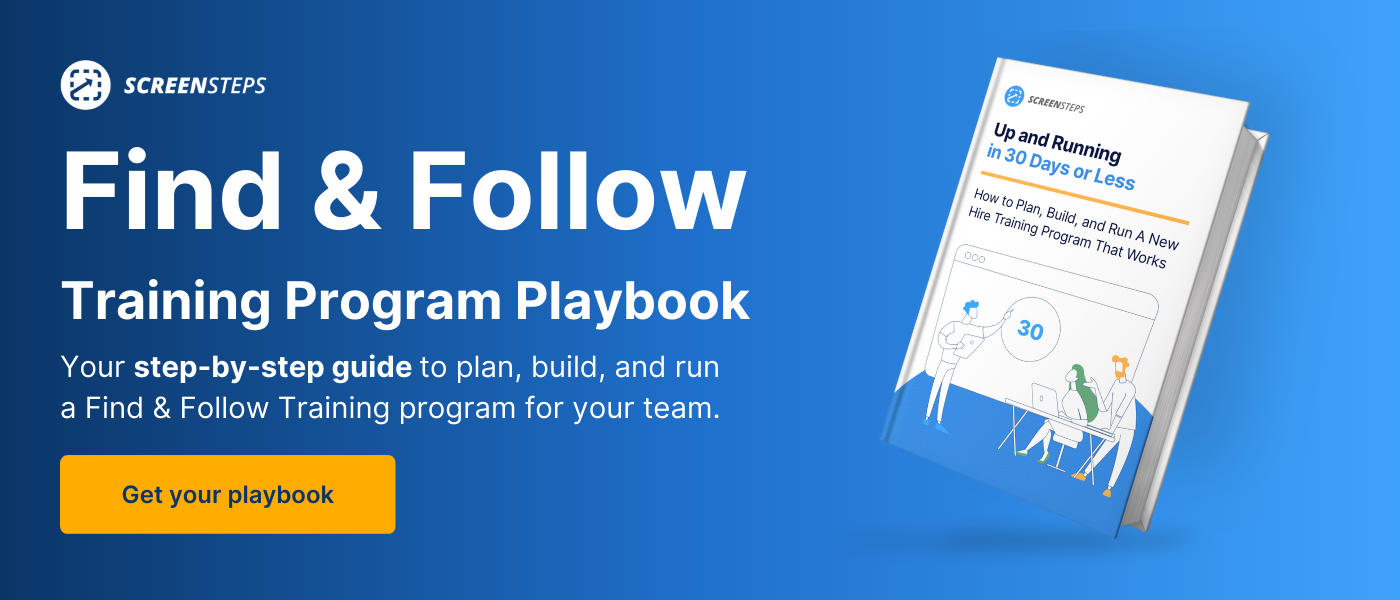11 Tips to Run an Effective New Hire Training
It typically takes 6–18 months for new hires to reach proficiency.
And by proficiency, I mean a new hire can handle most of their role’s tasks without needing additional help. Until new hires reach proficiency, they are relying on their supervisors and co-workers to help them.
I don’t know about you, but to me, it doesn’t sound like the new hire training program is working.
Working for ScreenSteps — a knowledge ops solution that helps companies train new hires in 30 days or less — I’ve learned that training doesn’t have to involve long lectures and quizzes. There are more effective ways to train new hires.
You don’t have months or years to wait for a new hire to get up to speed. So how do you make new hire training more effective?
Follow these 11 tips to help refine your new hire onboarding program. This will help your new hires reach proficiency faster and training run smoother.
1. Know what you need employees to do
Build your new hire training curriculum around what you need employees to do.
One of the most common mistakes we see companies make with their training programs is they build their program around what they want employees to know.
Companies spend time creating quizzes asking new hires what they remember from training lectures. New hires pass these tests with flying colors. Then they finish training, enter the job, and they don’t know how to do their job.
They only have memorized knowledge — not actionable knowledge.
Make sure you build your employee training program so that employees finish training and feel confident handling tasks on their own. These other tips should help you do that.
2. Provide clear SOPs
Don’t go into training without any resources. Prior to training, creating clear standard operating procedures (SOPs).
Now, these SOPs aren’t just for training. These SOPs need to be resources that your new hires can continue to access and use while they are on the job.
The SOPs provide clear guidelines on how procedures should be handled.
3. Set clear expectations
Sometimes new hires get mixed messages about what is expected of them. Trainers tell them one thing. Mentors tell them another thing. And then supervisors have a whole different expectation.
Set a timeline and provide new hires with an overview of what they will be learning. Let them know where you expect them to be by the end of training.
HOT TIP
Align your training and operations team before creating your new hire training plan. Make sure both parties know what is expected of the new hires for their jobs.We recommend running a Find & Follow Workshop to help your team figure out what you need new hires to be able to do. Download a free worksheet here.
4. Use analogies
A lot of people forget what it’s like not to know, and that can be a hindrance to teaching new hires.
One way to simplify teaching is to use analogies.
Use analogies and stories to explain concepts. Use real-life examples that everyone in your new hire onboarding group can relate to.
For example, we often use recipes to explain step-by-step SOPs because most people have used a recipe before to cook something.
5. Set time limits
If you’re the trainer, don’t go long on your explanations. Often, trainers go off-script and accidentally dive too deep into the details of how-tos and rare case scenarios.
Hey, we don’t blame you. It’s the curse of knowledge.
You only want to provide context in your lectures — not detailed step-by-step, click-by-click instructions.
HOT TIP
If you want to prevent yourself from going off on tangents, create a foundational course and commit to staying on script. A foundational course lasts about 10–20 minutes for one topic. Use this free Google Slides template for creating your foundational course.
6. Spend the bulk of training role-playing
New hires aren’t going to remember everything the trainer says during onboarding. So building a new hire training curriculum around your employees memorizing everything they need to know isn’t going to work.
Instead, spend the majority of your new hire training session role-playing. Another word for this is scenario-based training.
The goal is to provide as many realistic hands-on experiences as possible. You do this by running practice activities using real scenarios the new hires will encounter on the job.
🔎 Related: Scenario-Based Training: Role-playing Examples for Call Center Training
7. Encourage open communication and questions
Make training a safe place. Encourage your new hires to ask questions.
Take the time to walk around the room so that your new hires have an opportunity to ask follow-up questions as they run through scenarios. Be positive as you answer questions. Seek to empower your new hires.
8. Let new hires struggle

During role-playing sessions, it is tempting to jump in when a new hire makes a mistake or is stuck. Let your new hire work through the procedure.
If they are completely stuck, prompt them on the next step, but don’t give them the answer. Once they have finished the practice scenario, you can provide feedback.
Why is it important to let your new hires struggle? It’s because you won’t be there to rescue them on the job. Your new hires need to learn to troubleshoot and work through a challenge on their own.
It’s better that they struggle in a fake, low-risk practice situation than when they are handling real situations on the job.
9. Leverage software applications
We live in a modern world full of technology solutions. Leverage different software applications to help with your training.
Some of the best software applications you may consider include a learning management system (LMS) or a knowledge base.
An LMS is an eLearning library where employees can self-service courses. A knowledge base is a place to manage your employee support resources like standard operating procedures (SOPs), reference guides, and policies.
10. Centralize all your training materials
Speaking of technology, choose software to centralize all of your training materials. When you centralize your training materials, your employees know exactly where to go if they have a question or need a refresher on a topic.
Often, companies will have a technology stack, like the two software applications mentioned in the last point. Another option is a knowledge ops platform.
A knowledge ops platform has all the same features as a knowledge base. Plus, it has a course feature so that all your training materials are in one location.
11. Gather feedback
When a new hire onboarding session is finished, your job isn’t done. Gather feedback from your new hires. Figure out what went well and where you could improve the new hire training program.
Then refine your training curriculum for the next session.
Build a new hire training program that produces confident and independent employees
When it comes to building a new hire training curriculum, it helps to have a framework to help you build all the right resources.
The Find & Follow Framework helps you create a new hire training plan that prepares your employees to take action after completing training.
Companies that have adopted Find & Follow have trained their employees in 30 days or less. And their employees are making fewer mistakes and improving their employee performance metrics.
When one call center first adopted Find & Follow, their new hires started outperforming their tenured agents.
Want to see if the Find & Follow Framework is the right approach for your new hire training?
Download the free Find & Follow playbook. Or if you prefer, take the free 30-minute Find & Follow Basics course.
Both resources will help you determine whether Find & Follow is the right solution for your training program. Or, at the very least, you may get some ideas to improve your new hire training curriculum.




